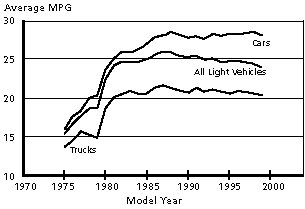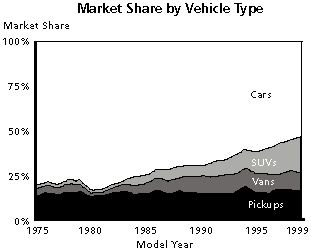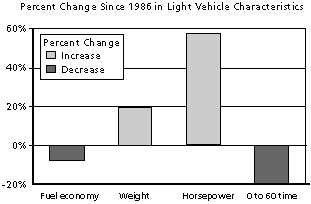Light-duty automotive technology and fuel economy trends
through 1999
Fuel economy is on the decline.
provided by United States Environmental
Protection Agency
|
| |
 new US Environmental Protection Agency's (EPA) report
summarizes the key trends related to the fuel economy of light
vehicles sold in the United States for model years 1975 through
1999. "Light vehicles" include those vehicles that
US EPA and the US Department of Transportation (DOT) classify
as cars or light-duty trucks (sport utility vehicles, minivans,
and pickup trucks with less than 8,500 pounds gross vehicle weight
ratings). The report finds that fuel economy is declining, truck
market share is increasing, and fuel economy is being traded
for vehicle weight and performance. new US Environmental Protection Agency's (EPA) report
summarizes the key trends related to the fuel economy of light
vehicles sold in the United States for model years 1975 through
1999. "Light vehicles" include those vehicles that
US EPA and the US Department of Transportation (DOT) classify
as cars or light-duty trucks (sport utility vehicles, minivans,
and pickup trucks with less than 8,500 pounds gross vehicle weight
ratings). The report finds that fuel economy is declining, truck
market share is increasing, and fuel economy is being traded
for vehicle weight and performance. |
Importance of fuel economy
|
| |
 Since
the early 1970s, EPA has issued reports that summarize fuel economy
data for new light vehicles. The fuel economy values in this
report are laboratory data similar to those that DOT uses for
compliance with the corporate average fuel economy standards.
These laboratory values, however, are significantly higher than
the estimated values used on new car labels and in the Fuel Economy
Guide. Since
the early 1970s, EPA has issued reports that summarize fuel economy
data for new light vehicles. The fuel economy values in this
report are laboratory data similar to those that DOT uses for
compliance with the corporate average fuel economy standards.
These laboratory values, however, are significantly higher than
the estimated values used on new car labels and in the Fuel Economy
Guide.
 Fuel economy
continues to be a major area of public and policy interest for
several reasons, including: Fuel economy
continues to be a major area of public and policy interest for
several reasons, including:
- Fuel economy is directly related to carbon
dioxide emissions, the most prevalent pollutant associated with
global warming, and light vehiclesontribute about 20 percent
of all US carbon dioxide emissions.
- Light vehicles account for approximately
40 percent of all US oil consumption. Crude oil, from which nearly
all light vehicle fuels are made, is considered to be a finite
natural resource.
- Fuel economy is directly related to vehicle
fueling cost.
|
Fuel economy is declining
|
| |
 The
average fuel economy for all model year 1999 light vehicles is
23.8 miles per gallon (MPG). Within this category, average fuel
economy is 28.1 MPG for passenger cars and 20.3 MPG for light-duty
trucks. The 1999 fuel economy average is the lowest value since
1980 and is 2.1 MPG less than the peak value of 25.9 MPG achieved
in both 1987 and 1988. Average fuel economy for new light vehicles
has dropped 1.0 MPG since 1996. The
average fuel economy for all model year 1999 light vehicles is
23.8 miles per gallon (MPG). Within this category, average fuel
economy is 28.1 MPG for passenger cars and 20.3 MPG for light-duty
trucks. The 1999 fuel economy average is the lowest value since
1980 and is 2.1 MPG less than the peak value of 25.9 MPG achieved
in both 1987 and 1988. Average fuel economy for new light vehicles
has dropped 1.0 MPG since 1996.

 All of the
fleet-wide improvement in new light vehicle fuel economy occurred
from the middle 1970s through the late 1980s, but it has been
consistently falling since the late 1980s. Viewed separately,
the average fuel economy for new cars has been essentially flat
over the last 14 years, varying only from 27.6 MPG to 28.6 MPG.
Similarly, the average fuel economy for new light trucks has
been largely unchanged for the past 19 years, ranging from 20.1
MPG to 21.6 MPG. The increasing market share of light-duty trucks,
which have lower average fuel economy than cars, is the primary
reason for the decline in fuel economy of the overall new light
vehicle fleet. All of the
fleet-wide improvement in new light vehicle fuel economy occurred
from the middle 1970s through the late 1980s, but it has been
consistently falling since the late 1980s. Viewed separately,
the average fuel economy for new cars has been essentially flat
over the last 14 years, varying only from 27.6 MPG to 28.6 MPG.
Similarly, the average fuel economy for new light trucks has
been largely unchanged for the past 19 years, ranging from 20.1
MPG to 21.6 MPG. The increasing market share of light-duty trucks,
which have lower average fuel economy than cars, is the primary
reason for the decline in fuel economy of the overall new light
vehicle fleet.
|
Truck sales continue to Increase
|
| |
 Sales
of light-duty trucks, which include sport utility vehicles (SUVs),
minivans, and pickup trucks, have risen steadily for 20 years
and now make up 46 percent of the US market -- more than twice
their market share as recently as 1983. Sales
of light-duty trucks, which include sport utility vehicles (SUVs),
minivans, and pickup trucks, have risen steadily for 20 years
and now make up 46 percent of the US market -- more than twice
their market share as recently as 1983.

 Growth in
the light-duty truck market has been led recently by the explosive
popularity of SUVs, which rose in sales from less than 200,000
in 1975 (less than 2 percent of the overall new light vehicle
market) to almost 3 million in 1999 (20 percent of the market).
Over the same period, market share for minivans and full-size
vans doubled from 5 to 10 percent, and for pickup trucks grew
from 13 to 16 percent. Between 1975 and 1999, market share for
new passenger cars and wagons has fallen from 81 to 54 percent.
Based on lower average fuel economies and projected longer useful
lives, EPA estimates that the new light-duty trucks sold in 1999
will consume, over their lifetimes, almost 60 percent of the
fuel used by all of the new light vehicles sold in 1999. Growth in
the light-duty truck market has been led recently by the explosive
popularity of SUVs, which rose in sales from less than 200,000
in 1975 (less than 2 percent of the overall new light vehicle
market) to almost 3 million in 1999 (20 percent of the market).
Over the same period, market share for minivans and full-size
vans doubled from 5 to 10 percent, and for pickup trucks grew
from 13 to 16 percent. Between 1975 and 1999, market share for
new passenger cars and wagons has fallen from 81 to 54 percent.
Based on lower average fuel economies and projected longer useful
lives, EPA estimates that the new light-duty trucks sold in 1999
will consume, over their lifetimes, almost 60 percent of the
fuel used by all of the new light vehicles sold in 1999.
|
Fuel economy is being traded for weight and performance
|
| |
 More
efficient technologies have continued to enter the new light
vehicle fleet and are being used to increase light vehicle weight
and performance rather than fuel economy. Based on accepted engineering
relationships, if the new 1999 light vehicle fleet had the same
average weight and performance as in 1986, it could have achieved
5 MPG higher fuel economy. More
efficient technologies have continued to enter the new light
vehicle fleet and are being used to increase light vehicle weight
and performance rather than fuel economy. Based on accepted engineering
relationships, if the new 1999 light vehicle fleet had the same
average weight and performance as in 1986, it could have achieved
5 MPG higher fuel economy.

 More efficient
technologies -- such as engines with more valves and more sophisticated
fuel injection systems, and transmissions with extra gears --
have continued to penetrate the new light vehicle fleet. The
trend has clearly been to apply these new technologies to increase
average new vehicle weight, power, and performance while maintaining
fuel economy. This is reflected by heavier average vehicle weight
(up 20 percent for new light vehicles since 1986), rising average
horsepower (up 58 percent for new light vehicles since 1986),
and lower 0 to 60 mile-per-hour acceleration time (19 percent
faster for new light vehicles since 1986). During this same time,
average new light vehicle fuel economy fell by 7 percent. More efficient
technologies -- such as engines with more valves and more sophisticated
fuel injection systems, and transmissions with extra gears --
have continued to penetrate the new light vehicle fleet. The
trend has clearly been to apply these new technologies to increase
average new vehicle weight, power, and performance while maintaining
fuel economy. This is reflected by heavier average vehicle weight
(up 20 percent for new light vehicles since 1986), rising average
horsepower (up 58 percent for new light vehicles since 1986),
and lower 0 to 60 mile-per-hour acceleration time (19 percent
faster for new light vehicles since 1986). During this same time,
average new light vehicle fuel economy fell by 7 percent.
|
For more Information
|
 |
 The
report "Light-Duty Automotive Technology and Fuel Economy
Trends Through 1999" (EPA420-R-99-018) is available on the
Office of Mobile Sources web site at: www.epa.gov/oms/mpg.htm The
report "Light-Duty Automotive Technology and Fuel Economy
Trends Through 1999" (EPA420-R-99-018) is available on the
Office of Mobile Sources web site at: www.epa.gov/oms/mpg.htm
 Printed copies
are available from: US Environmental Protection Agency, National
Service Center for Environmental Publications, PO Box 42419,
Cincinnati, OH 45242-2419; (800) 490-9198. Printed copies
are available from: US Environmental Protection Agency, National
Service Center for Environmental Publications, PO Box 42419,
Cincinnati, OH 45242-2419; (800) 490-9198. 
|
![]()
![]()
![]()
![]()
![]()
![]()
![]()
![]()
![]()
![]()
![]()
![]()
![]()
![]()
